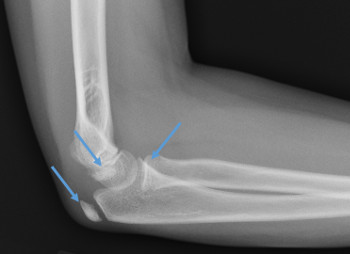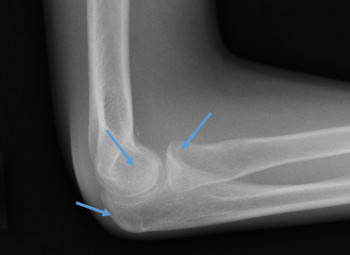Description
Overuse injuries in children are aches, pains and sometimes even broken bones that result from repeated motions like throwing, running, and kicking.
There are many benefits to children who participate in regular sports and exercise. These include both physical and emotional well-being. Greater confidence, concentration, social skills, team building, and overall health are all seen in children and young adults who participate in sports and exercise regularly. Young people who exercise are more likely to be healthier, and less likely to be obese. Pediatric orthopedic surgeons are dedicated to helping young people remain active.
So how much is too much? There are few scientific answers to this question. It is up to us as parents, doctors, and coaches to encourage young athletes to listen to their bodies and report aches and pains to us. Aches and pains should be evaluated by a physician before encouraging a young person to “play through” any pain. A persistent limp or swelling, pain at rest or night indicates a need to see a pediatric orthopedic surgeon.
Types of Overuse Injuries
Overuse injuries include:
- Little leaguer’s shoulder (growth plate stress injury)
- Little leaguer’s elbow (medial epicondyle avulsion stress fracture and/or capitellum osteochondritis dissecans)
- Hip pain (apophyseal traction pain vs. tendon overuse)
- Stress fractures of the hip (apophyseal avulsion forces vs. upper femoral stress fracture vs. slipped epiphysis, etc.)
- Knee pain (tibial tubercle apophyseal traction as in Osgood-Schlatters, osteochondritis dissecans of the femur, patellar tendonitis, etc.)
- Ankle pain (Achilles overuse in tendon or at insertion at heel growth plate, accessory navicular, traction apophysitis at base of 5th metatarsal, etc.)
- Shin splints (overpull of the muscle and strong tissue attachments at the surface of the tibia bone)
- Stress fractures of the tibia (shin) and foot; bone injury occurs with continued exercise beyond the bone's ability to heal
Overuse injuries include problems with the soft tissues that can become inflamed. The most common is tendonitis, inflammation of the tendon which attaches the muscle to bone. In children, the tendon itself is very strong and not as prone to injury as adults. However, the tendon attachment is frequently at a growing end of the bone. The pain usually comes from the tug-of-war forces at this attachment.
Sometimes bones can get pounded so much that they break from stress, also known as stress fractures. These can happen in the hip (femoral neck), shin bone (tibia), and foot (metatarsal).
Symptoms
The most common complaint is pain. Swelling at the location of maximal tenderness may be seen. The pain usually gets worse with activity and better with rest.
Examination
Your doctor will carefully examine the involved body part. A pediatric orthopedic surgeon will try to locate the area of tenderness, often at a growth area in younger patients. Other regions nearby will need to be examined (such as the hips if a knee is painful). This is necessary because pain felt in the knee may be coming from the hip, especially in younger children. Your doctor may stress and test the soft tissues and the bones. Just as important as the examination is the history of how much activity there has been.
X-rays and Tests
X-rays do not pick up injury to the soft tissue, but are normally taken to be sure that there is no injury to the bone. X-rays may show stress fractures. Your doctor may choose to get an MRI scan if they are worried about stress fracture or bone fracture. Your doctor is not likely to need an MRI scan to diagnose tendonitis or other soft tissue inflammation or irritation. Pediatric orthopedic surgeons have frequent contact with young patients and use their experience to diagnose most conditions with a good history, physical exam and common X-rays. This experience helps to avoid unnecessary tests.

Xray of a skeletally immature elbow with open growth plates.

Xray of a skeletally mature elbow with closed growth plates.
Treatment:
The most important treatment is rest. Once the overuse injury gets better, return to sports should be gradual and with proper form. It is important to cross train and to take a few days off per week. Growing athletes should take a break several months per year from an individual sport.
Physical therapy may be helpful, especially for tendonitis or other soft tissue inflammation. It is important to evaluate and correct improper form in throwing, running, dancing and other sports. Younger children may be placed in casts if necessary to force the arm or ankle to rest.
Outcomes (Prognosis/Expectations)
Most overuse injuries get better once the proper rest and therapy is provided. The correct diagnosis can provide the best treatment and help avoid unnecessary tests or procedures. If an athlete returns to an unreasonable amount of activity without taking proper rest periods and cross training, these injuries can return and worsen. Surgery is very rarely needed for these problems. When a condition does require surgical correction, a pediatric orthopedic surgeon has special training in the growing child’s anatomy.
More Information
Page QR Code:

Q: What are the benefits of exercise for children and adolescents?
There are many benefits to children who participate in regular sports and exercise. These include both physical and emotional well-being. An increase in confidence, concentration, social skills, team building, and overall health are all seen in children and young adults who participate in sports and exercise regularly. Young people who exercise are more likely to be healthier, and less likely to be obese. Pediatric orthopedic surgeons are therefore dedicated to helping young people remain active.
Q: How much is too much?
There are few scientific answers to this question. Ultimately, it is up to us as parents, doctors, and coaches to encourage young athletes to listen to their bodies and report aches and pains to us. When your surgeon determines structural damage to a growing bone, joint, or tendon structures is occurring, your child’s activities need to be modified.
Q: Should I tell the athlete to play through the pain?
Aches and pains should be evaluated by a physician before encouraging a young person to “play through” any pain. As parents, we have to ‘filter’ many of our children’s symptoms. When pain causes children to stay out of activity, or a visible limp or swelling occurs, it is time to see a pediatric orthopedic surgeon.
Q: What is Tendonitis?
Overuse injuries include problems with inflammation of soft tissues. The most common is tendonitis, inflammation of the tendon that attaches muscle to bone. In children, the tendon itself is very strong and not as vulnerable to injury as adult structures. However, the attachment is frequently at a growing end of the bone. The pain usually comes from the tug-of-war forces at this attachment.
Q: What is a stress fracture? Is it different from a broken bone?
Sometimes bones can get pounded so much that they break from stress, also known as stress fractures. These can happen in the hip (femoral neck), shin bone (tibia), and foot (metatarsal). A stress fracture is a type of broken bone and should be taken just as seriously.
Q: When are xrays necessary for overuse injuries?
X-rays do not pick up injury to the soft tissue, but are normally taken to be sure that there is no injury to the bone. X-rays may show stress fractures.
Q: Do I need an MRI?
Your doctor may choose to get an MRI scan if they are worried about a stress fracture or bone fracture that is not seen on X-ray, but an MRI scan is usually not needed to diagnose tendonitis or other soft tissue inflammation.
Q: What can I do to get better?
The most important treatment is rest. Once the overuse injury gets better, return to sports should be slow. It is important to cross train and to take a few days off per week , and a few months off per year from any particular sport for a growing athlete.
Physical therapy may be helpful and necessary, especially for tendonitis or other soft tissue inflammation. It is important to evaluate and correct improper form in throwing, running, dancing and other sports.
Q: Will this get better?
Most overuse injuries get better once the proper rest and therapy is provided. If an athlete returns to an unreasonable amount of play without taking proper rest periods and cross training, these injuries can return and worsen. Without rest, these problems are very difficult to make better. A pediatric orthopedic surgeon is specially trained in the problems that affect young patients. These conditions are not ‘miniature’ versions of what we may have as adults. The causes and treatment options are often very different from adult conditions.

 POSNA.org
POSNA.org


